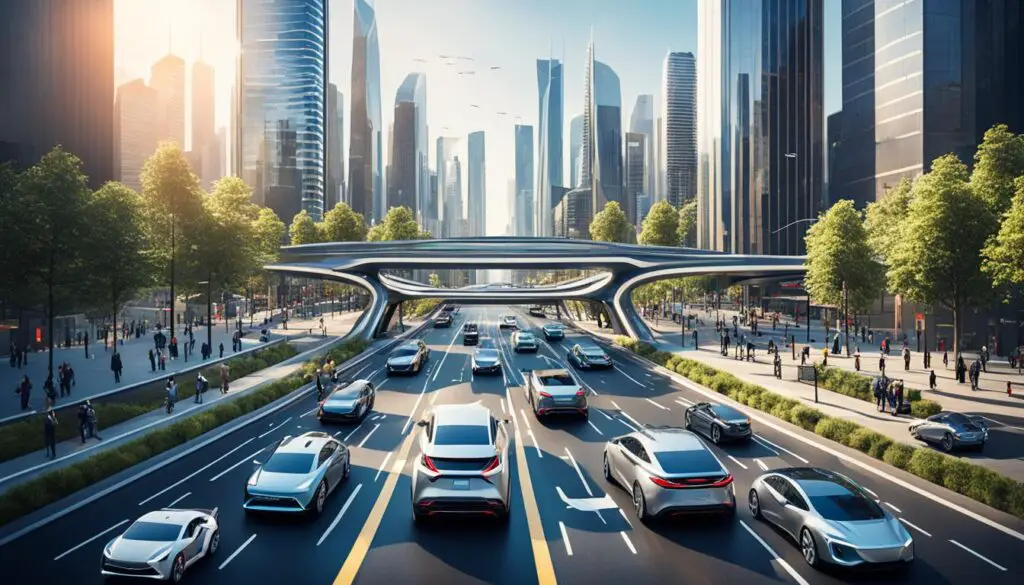
Navigating the Urban Jungle: Smart Traffic Management Solutions
Smart traffic management solutions are at the forefront of addressing the challenges posed by traffic congestion in our bustling cities. As urban areas experience rapid population growth and increased mobility demands, innovative technologies and strategies are essential to improve traffic flow and enhance urban mobility. This article explores the concept of smart traffic management and highlights cutting-edge solutions being used to tackle the complexities of the urban jungle.
The Benefits of Smart Traffic Management
Smart traffic management offers numerous benefits for urban areas. By leveraging advanced technologies such as real-time traffic monitoring, data analytics, and intelligent transportation systems, cities can optimize the flow of traffic, reduce congestion, and improve overall transport efficiency.
These solutions enable the implementation of dynamic traffic control measures, such as adaptive traffic signal systems and variable speed limits, which can be adjusted in real-time based on current traffic conditions. This results in smoother traffic flow, shorter travel times, and reduced fuel consumption and emissions.
Efficient Transport Systems
Smart traffic management plays a crucial role in creating efficient transport systems. By utilizing real-time traffic data and advanced analytics, cities can identify bottlenecks and optimize traffic flow by adjusting signal timings and implementing strategies to alleviate congestion points. This allows for a more efficient movement of vehicles, reducing travel times and improving the overall commuting experience for drivers.
Traffic Flow Optimization
One of the primary goals of smart traffic management is to optimize traffic flow. Through the use of intelligent technologies, traffic patterns can be analyzed, and control measures can be dynamically adjusted to accommodate changing traffic conditions. This ensures that traffic is distributed evenly, reducing congestion and improving the overall flow of vehicles on the road.
Intelligent Transportation Systems
Intelligent transportation systems (ITS) are a key component of smart traffic management. These systems utilize advanced technologies such as sensors, cameras, and communication networks to collect real-time data and enable proactive traffic management. By integrating ITS into traffic control systems, cities can make informed decisions and implement measures to enhance traffic efficiency and minimize disruptions.
Implementing smart traffic management solutions can lead to significant improvements in urban mobility, creating a more seamless and efficient transportation network for cities.
Overall, smart traffic management offers a range of benefits, including efficient transport systems, optimized traffic flow, and the use of intelligent transportation systems. By embracing these innovative solutions, cities can pave the way for a more connected and sustainable urban environment.
Innovative Solutions for Smart Traffic Management
Effective traffic management is paramount in urban areas, and innovative solutions are continuously being developed and implemented to tackle this challenge head-on. These solutions leverage cutting-edge technologies and data-driven approaches to optimize traffic flow, enhance safety, and promote sustainable transportation systems.
Connected Vehicles: Transforming Urban Mobility
One of the game-changing advancements in smart traffic management is the introduction of connected vehicle technology. This technology enables vehicles to communicate with each other and with infrastructure, creating a network of real-time traffic data. By exchanging information on traffic conditions and travel patterns, connected vehicles help to proactively manage traffic and reduce congestion.
Connected vehicles offer numerous benefits for urban mobility:
- Improved safety: By alerting drivers to potential hazards and providing warnings about unsafe conditions, connected vehicles contribute to the overall safety of the road network.
- Enhanced efficiency: With access to real-time traffic information, drivers can make informed decisions about their routes, reducing travel time and fuel consumption.
- Optimized traffic flow: By coordinating with traffic management systems, connected vehicles can support the implementation of adaptive signal control, optimizing traffic signal timings and reducing delays.
The integration of connected vehicles into smart traffic management systems paves the way for a more efficient and collaborative transportation ecosystem.
Smart Intersections: Ensuring Smooth Traffic Flow
Another key aspect of smart traffic management is the utilization of smart intersections equipped with advanced sensors and cameras. These intelligent intersections can detect and respond to traffic patterns in real-time, allowing for optimized signal timings and reduced congestion.
Benefits of smart intersections include:
- Dynamic signal control: By analyzing traffic volumes and patterns, smart intersections can adjust signal timings to accommodate changing traffic conditions, ensuring efficient traffic flow.
- Pedestrian safety enhancements: Sensor-based technology can detect pedestrians and provide priority crossing times, improving safety for both pedestrians and drivers.
- Efficient use of road space: With accurate data on traffic flow, smart intersections can optimize lane use and reduce wasted road capacity, leading to increased transport efficiency.
By harnessing the power of smart intersections, cities can create safer and more efficient road networks that benefit both commuters and pedestrians alike.
Intelligent Traffic Management Systems: Leveraging Advanced Analytics
Intelligent traffic management systems play a pivotal role in harnessing the vast amount of traffic data available today. Through advanced analytics and machine learning algorithms, these systems can predict traffic patterns, identify congestion points, and adjust traffic control measures accordingly.
Key features of intelligent traffic management systems include:
- Data-driven decision-making: By analyzing historical and real-time data, intelligent traffic management systems enable authorities to make informed decisions regarding traffic management strategies and interventions.
- Real-time monitoring and alerts: These systems provide continuous monitoring of traffic conditions and issue alerts when anomalies or potential issues are detected, allowing for proactive management and swift response.
- Adaptive control mechanisms: Leveraging data-driven insights, intelligent traffic management systems can dynamically adjust traffic signal timings, lane assignments, and other control measures to optimize traffic flow and alleviate congestion.
With the implementation of intelligent traffic management systems, cities can harness the power of data to make informed decisions and shape the future of transportation.
As the table below demonstrates, these innovative solutions for smart traffic management offer a range of benefits:
| Connected Vehicles | Smart Intersections | Intelligent Traffic Management Systems |
|---|---|---|
| Improved safety | Dynamic signal control | Data-driven decision-making |
| Enhanced efficiency | Pedestrian safety enhancements | Real-time monitoring and alerts |
| Optimized traffic flow | Efficient use of road space | Adaptive control mechanisms |
Innovative solutions such as connected vehicles, smart intersections, and intelligent traffic management systems are revolutionizing the way traffic is managed in urban areas. By harnessing the power of technology, data, and analytics, cities can create safer, more efficient, and sustainable transportation systems for everyone.

Conclusion
Smart traffic management solutions are vital for addressing the increasing traffic challenges faced by growing cities. By leveraging technology and data, cities can create transport systems that are more efficient and sustainable, ultimately improving urban mobility.
The future of transportation lies in the integration of smart traffic management with other smart city solutions. By combining smart traffic management with innovations such as smart parking, public transportation optimization, and multimodal mobility platforms, cities can create a comprehensive and interconnected urban ecosystem.
With continued investment and innovation in smart traffic management, we can build a more connected, efficient, and sustainable urban environment for the future. These smart city solutions are not only transforming how we navigate our cities but also paving the way for a brighter and more accessible future of transportation.
FAQ
What is smart traffic management?
Smart traffic management refers to the use of advanced technologies and strategies to optimize the flow of traffic, reduce congestion, and improve overall transport efficiency in urban areas.
What are the benefits of smart traffic management?
Smart traffic management offers numerous benefits, including smoother traffic flow, shorter travel times, reduced fuel consumption and emissions, and improved overall transport efficiency.
What innovative solutions are being used for smart traffic management?
Innovative solutions for smart traffic management include connected vehicle technology, which allows vehicles to communicate with each other and with infrastructure, smart intersections equipped with sensors and cameras to optimize traffic signal timings, and intelligent traffic management systems that leverage advanced analytics to predict traffic patterns and adjust control measures accordingly.
How does smart traffic management contribute to urban mobility?
By leveraging technology and data, smart traffic management solutions create more efficient and sustainable transport systems, improving urban mobility and navigating the growing challenges of traffic congestion in cities.
How does smart traffic management integrate with other smart city solutions?
Smart traffic management can be integrated with other smart city solutions, such as smart parking, public transportation optimization, and multimodal mobility platforms, to create a more connected and efficient urban environment for the future.
Source Links
- https://www.arnoldclark.com/used-cars/seat/arona/1-0-tsi-se-technology-ez-5dr/2021/ref/arnbj-u-94262
- https://energy.economictimes.indiatimes.com/news/oil-and-gas/as-congo-seeks-to-expand-drilling-some-communities-worry-pollution-will-worsen/108136769
- https://bfsi.economictimes.indiatimes.com/news/editors-view/climate-risks-in-finance/108121998
